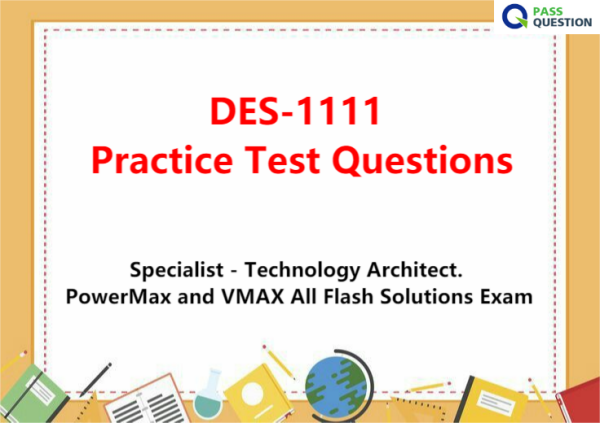DES-1111 Practice Test Questions - Specialist - Technology Architect. PowerMax and VMAX All Flash Solutions Exam
If you are looking for high success rate in DES-1111 Specialist - Technology Architect. PowerMax and VMAX All Flash Solutions Exam , then you should go through PassQuestion DES-1111 Practice Test Questions. The DES-1111 Practice Test Questions cover all the topics that you need to prepare before taking your DES-1111 exam. DES-1111 Practice Test Questions that contain all the relevant information about the DES-1111 exam so that you can achieve your desired results. After studying DES-1111 questions and answers, we ensure you to go through all certification topics and provides you ultimate satisfaction to pass your exam in your first attempt.

Specialist - Technology Architect. PowerMax and VMAX All Flash Solutions Exam
This is the qualifying exam for the Specialist - Technology Architect, PowerMax and VMAX All Flash Solutions Specialist (DCS-TA) track. This exam focuses on designing and positioning PowerMax and VMAX All Flash solutions, including storage allocation, monitoring, workload planning and virtualized environment management. The ability to size PowerMax and VMAX All Flash arrays and design SRDF solutions with Business Continuity Solution Designer is assessed. The exam also assesses the ability to demonstrate the usage of Unisphere and Solutions Enabler SYMCLI to manage configuration changes as well as local and remote replication solutions.
Exam Details
Exam Code: DES-1111
Exam Name: Specialist - Technology Architect, PowerMax and VMAX All Flash Solutions Exam
Number of Questions: 60
Duration: 90 Minutes
Pass Score: 63
Exam Objectives
PowerMax and VMAX All Flash Features (20%)
● Compare and contrast PowerMax and VMAX All Flash models
● Position PowerMax and VMAX All Flash solutions
● Identify PowerMax and VMAX All Flash management tools
● Explain Virtual Provisioning concepts
● Describe device and port management concepts
Business Continuity (10%)
● Overcoming business continuity business challenges
● Describe Remote Replication Network Connectivity options
● Identify SRDF features and solutions
● Explain Open Replicator concepts
Replication (20%)
● Describe TimeFinder SnapVX concepts
● Perform TimeFinder SnapVX operations using management tools
● SRDF/S architecture and design considerations
● RDF/A architecture and design considerations
● SRDF/Metro architecture and design considerations
Virtualized Environments (10%)
● Describe administrative tasks such as replicating and recovering a datastore
● Key considerations for implementing PowerMax and VMAX All Flash in virtualized environments
Design and Sizing for PowerMax and VMAX All Flash (30%)
● Monitor PowerMax and VMAX All Flash SRPs, compliance, and data reduction
● Perform Workload Planning activities with Unisphere for PowerMax
● Identify design options and best practices
● Provide overview and data collection techniques for BCSD
● Design SRDF solutions with BCSD
● Create PowerMax and VMAX All Flash sizing and upgrade solutions with VMAX Sizer
Unisphere for PowerMax (10%)
● Describe architecture and key features of Unisphere for PowerMax
● Install Unisphere for PowerMax
● Navigate the Unisphere interface
● Perform administrative tasks using Unisphere for PowerMax
View Online Specialist - Technology Architect, PowerMax and VMAX All Flash Solutions DES-1111 Free Questions
What needs to be created in BCSD to link multiple SRDF/A sessions?
A.Composite Group
B.Logical relationship
C.Consistency Group
D.MSC logical relationship
Answer : C
SRDF/A has been enabled between two PowerMax arrays. An extended loss of all RDF links occurs.
What is the state of the RDF pair after link connectivity is restored?
A.Split
B.Failed Over
C.Suspended
D.Partitioned
Answer : D
A TimeFinder SnapVX snapshot of source volumes is linked to target volumes. The target volumes are being used for application testing.
What is recommended prior to a relink operation?
A.Stop accessing both the source volumes and the target volumes
B.Continue accessing the source volumes; stop accessing the target volumes
C.Stop accessing the source volumes; continue accessing the target volumes
D.Continue accessing both the source volumes and the target volumes
Answer : D
What is a characteristic of SRDF/Metro?
A.Data must be stored in cache on both sides before an acknowledgement is sent to the host.
B.Multiple capture sets permit smaller cycles of data to be buffered on the R1 side and transferred to the R2 side.
C.A dependent-write consistent copy is maintained between the R1 and R2 devices.
D.Devices that have the Consistency Exempt attribute set can be controlled independently of the other devices.
Answer : C
What action can an administrator perform on a PowerMax using VSI?
A.View replication sessions
B.Manage High Availability
C.Manage re-syncing objects
D.View capacity utilization
Answer : A
A customer is planning an SRDF/S implementation. They are concerned about the performance of their application when the initial synchronization of the data occurs.
Which SRDF mode should be used during the initial synchronization period?
A.Mixed
B.Adaptive copy disk
C.Dynamic RDF
D.SRDF/A
Answer : B
Comments
Post a Comment